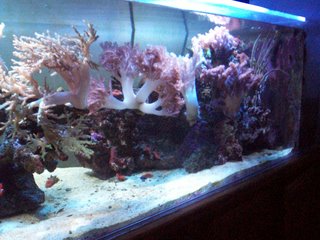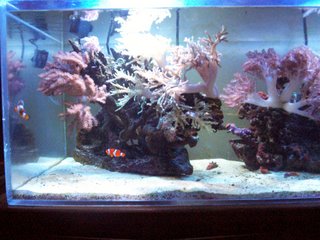Example Schedule
1st 24 hours w/c at 1hour and 12 hours.
24-72 hours w/c every 12 hours.
3rd –28th day w/c every 24 hours.
Plus two days for good measure, completing the 30 day QT.
Lighting
Most QT systems lighting will not be as intense as the main tank. Close is good. If it is as bright or brighter there might be a need for some screening. Keep on the photoperiod as the main display.
(Sometimes it is necessary to give up some color for the long term health of the organism. The color can be back in a coral in just a few weeks in the main display.) *Remember it’s not brown it’s “chocolate.”
Traps
Keep a trap in the QT on a continuous basis. Be mindful that the food in the trap should be changed out regularly. Don’t let it foul the water or your newly prized “uber rare LE” frag will be lost.
Aquascaping
A platform made from PVC pipe and egg crate work the best for most applications. You can find it all at Friedman Brothers. Remember shop local.
Bare bottom.
Unwanted pests are easier to see.
Water volume is easier to calculate.
Less organisms to add to the bio-load the better.
The rule of 6 - if multiple coral frags are in one system keep at laest 6 inches in all directions between each coral. Same species are safe near each other. (alleopathy)
If you introduce a new coral to an existing QT system with corals the clock turns back to day 1.
Tips
Remove any and all plugs, rocks from corals before putting in the QT system. Little critters love to hide out in the cracks and crevices.
Don’t attach freshly fraged corals to plug or rock. Give the coral time to heal.
Keep QT system separate from your main system.
Do not mix equipment from system to system. (Algae pads, hoses, nets, ect.)
Sterilize everything that comes out of the QT 1/2 oz bleach per gallon for at least 5 min. Declor (Sodium Thyoslfate) and rinse in hot water for 10 min. Let dry.
After the QT is over break down the system clean and sterilize everything.
Keep a log.
Post your experiences on-line.
Remember to share your results with other hobbyists.
Preventatives, Dips and Drugs.
Melafix
Prazi-pro
Flatworm exit
Aptasia control
Interceptor
Iodine (lugol’s solution)
Tropic Marin pro coral dip
Medication removal
Water changes. “Dilution is the solution to pollution.”
GAC-Granulated Activated Carbon
Poly filter
Chemi-pure
Protein Skimming
This Last Section I got straight off a web page that does not exist any more. It probably is posted some where else too.
The Red Bug Treatment
*******Disclaimer*******
If you use this medication it is at your own risk. No one but yourself is responsible for your actions with this medication. Please read carefully and follow the directions. This medication will most likely kill off all crustaceans in your aquarium.
If you use this medication it is at your own risk. No one but yourself is responsible for your actions with this medication.
------------------
The medication is a DOG heartworm medication called Interceptor, it is only available from a veterinarian with a prescription. The tablets used in the initial treatments were for large dogs, 51-100lbs. These tablets are just under 1 gram each and contain 23mg of Milbemycin Oxime, the rest of it is a lovely smelling beef flavor. This chemical is active against Nematodes (Heartworms in dogs) and select arthropods (some types of Mange in dogs). Luckily, our red bugs are one of those select arthropods. The tablets come 6 to a box.
Here is the official information from Novartis on the medication.
Refer to this thread and read the whole thing before you begin the treatment.
The dosage used in an aquarium to kill redbugs is 25mg (0.025 grams) per 10 gallons of actual tank water. That is 25mg of the entire tablet. Each tablet in the pack of 6 will treat about 380 gallons. The tablets are ground with a mortar and pestle into a fine powder.
Do you’re very best to calculate your actual water volume. Take into consideration your sump, oversized plumbing and things like that. All of the initial tests were done with the estimated volume of live rock and live sand subtracted from the total gallons. You need to make sure that every part of the system that’s capable of holding water is treated. This means your refugium, the water inside your calcium reactor, the water inside your skimmer while it is not foaming. It’s easier to calculate in a bare bottom system.
Measure out the Interceptor on a very accurate scale that is capable of reading down to 0.001 grams. Remember, the dosage is 0.025grams per 10 gallons. For safety’s sake get as close as you possibly can. It has been pointed out that it may not be necessary to get down to the 1/1000th of a gram point when we are guessing on the actual water volume. This is an excellent point, however, since we are pretty much guessing our water volume, we should do our very best to make sure that we treat that guess accurately. We don’t want to over treat an over estimate.
Before adding the medication to your tank, turn off your skimmer (water needs to run through it, but you do not want it producing any bubbles. Remove any mechanical filtration if present. Remove any carbon if present. Turn off UV sterilizers and ozone generators.
Remove any shrimp or crabs that you want to save. They will have to stay out of the system for the duration of the treatment. Remember, that when you add them back to your tank, there is a slight chance that you will re-introduce the red bugs to your tank.
The medication is dissolved into some aquarium water (it is not easily soluble, you will have to stir for a while) and spread evenly across the surface of the water. Your tank should remain perfectly clear and look very normal the entire time. The bugs hang on well into the 4th and 5th hour of the treatment, don’t be alarmed. Many of the bugs will hang on for days even after they are dead.
If anything goes wrong during treatment perform a water change ASAP and add a large amount of carbon to your system.
After 6 hours, a 25% MINIMUM water change is performed and as much activated carbon as you can fit should be added to the tank. Normally for general maintenance most tanks it is about 1 cup per 100 gallons. For SPS systems it is a 1/2cup per 100 gallons. So doubling or even tripling it to remove medication is the way to go. In the initial tests, crustaceans that were reintroduced to a tank after a 25% water change and carbon were unaffected by the medication.
24 hours later the water should be changed again and the carbon replaced.
There is no maximum for the water changes or carbon, the more you do the better.
The treatment needs to be performed a MINIMUM of 3 times. We know it kills the bugs, but we don’t know enough about their lifecycle to determine if it kills them at every stage of their life. We have to assume that all of the most of the adults are killed in the first treatment. The goal of the second treatment is to clean up any left over adults, and any juveniles that have hatched out of eggs that might have been unaffected. The third treatment is a just in case treatment, its goal is to get any bugs that could have possibly survived the first two. I know that three treatments sounds scary, after the first one you will feel much more comfortable with it though.
The frequency of the treatment: Depending on infestation. I have been done 2 treatments 24 hours apart every 7 days. I will repeat this 4 times for a total of 8 treatments. For a light infestation, 3 treatments every twenty four hours usually does the trick.
The medication seems to be fairly safe, it is best to err on the side of caution and treat several times. Pretend its an antibiotic, if your going to use it once, make sure you do the whole treatment process at least 3 times!!!




